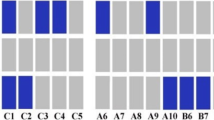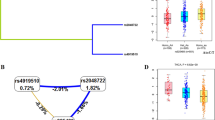Abstract
Purpose
This study aims to investigate the relationship between the TSHR, BRAF, and PIK3CA gene copy number variations (CNVs) and thyroid nodules by analyzing gene CNVs, and to explore the interaction between iodine status and the above genes CNVs in the occurrence of thyroid nodules.
Methods
Three hundred and ninety-five subjects were selected from 3 regions with different iodine status in Shanxi Province of China, including 192 patients with thyroid nodules and 203 healthy controls. The basic information about subjects had been obtained through a questionnaire. B ultrasound was utilized to check thyroid nodules. Blood and urine samples were harvested to detect the thyroid function and urinary iodine concentration. Real-time quantitative polymerase chains reaction (RT-PCR) served to detect CNVs in DNA from human blood.
Results
There was an association between TSHR gene CNV and thyroid nodules (χ2 = 8.403, P = 0.004). The prevalence of BRAF and PIK3CA gene CNVs was not statistically significant between the case group and the control group. Differences in the TSHR gene CNV rates for cases of the 3 areas were statistically significant (χ2 = 10.072, P = 0.007). No statistical difference in the prevalence rates of the 3 genes CNVs between diverse characteristics of thyroid nodules was observed. UIC > 300 μg/L (OR = 1.74, 95% CI: 1.02–2.96, P = 0.041) and TSHR gene CNV (OR = 3.53, 95% CI: 1.40–8.92, P = 0.008) were risk factors for thyroid nodules. There was no significant interaction between the UIC and the examined genes CNVs.
Conclusions
TSHR gene CNV and high urinary iodine levels can increase the risk of thyroid nodules. But the interactions between the 3 above genes CNVs and iodine nutrition were not found in the occurrence of thyroid nodules.



Similar content being viewed by others
References
B.R. Haugen, E.K. Alexander, K.C. Bible, G.M. Doherty, S.J. Mandel, Y.E. Nikiforov et al. 2015 American Thyroid Association Management Guidelines for Adult Patients with Thyroid Nodules and Differentiated Thyroid Cancer: The American Thyroid Association Guidelines Task Force on Thyroid Nodules and Differentiated Thyroid Cancer. Thyroid 26(1), 1–133 (2016). https://doi.org/10.1089/thy.2015.0020
L.R. Remonti, C.K. Kramer, C.B. Leitao, L.C. Pinto, J.L. Gross, Thyroid ultrasound features and risk of carcinoma: a systematic review and meta-analysis of observational studies. Thyroid 25(5), 538–550 (2015). https://doi.org/10.1089/thy.2014.0353
Y. Yao, X. Chen, S. Wu, L. Guo, H. Zhang, Q. Zhu et al. Thyroid nodules in centenarians: prevalence and relationship to lifestyle characteristics and dietary habits. Clin. Inter. Aging 13, 515–522 (2018). https://doi.org/10.2147/CIA.S162425
G. Popoveniuc, J. Jonklaas, Thyroid nodules. Med Clin. North Am. 96(2), 329–349 (2012). https://doi.org/10.1016/j.mcna.2012.02.002
L. Giovanella, F. D’Aurizio, A. Campenni, R.M. Ruggeri, S. Baldari, F.A. Verburg et al. Searching for the most effective thyrotropin (TSH) threshold to rule-out autonomously functioning thyroid nodules in iodine deficient regions. Endocrine 54(3), 757–761 (2016). https://doi.org/10.1007/s12020-016-1094-3
J. Song, S.R. Zou, C.Y. Guo, J.J. Zang, Z.N. Zhu, M. Mi et al. Prevalence of thyroid nodules and its relationship with iodine status in Shanghai: a population-based study. Biomed. Environ. Sci. 29(6), 398–407 (2016). https://doi.org/10.3967/bes2016.052
J. Yi, Y. Dai, Y. Zhang, F. He,, Influencing factors of iodine nutrition and thyroid nodules among residents in Zhoushan. J. Preventive Med. 30(6), 600–602 (2018). https://doi.org/10.19485/j.cnki.issn2096-5087.2018.06.015
Y. Tian, J. Liu, X. Tang, S. Fu, L. Ma, W. Sun, Study on the relationship between adults iodine nutritional status and TSH, thyroid autoantibodies and thyroid nodules in Gansu. Acta Nutrimenta Sin. 41(3), 248–252 (2019). https://doi.org/10.3969/j.issn.0512-7955.2019.03.009
S.Y. Mon, G. Riedlinger, C.E. Abbott, R. Seethala, N.P. Ohori, M.N. Nikiforova et al. Cancer risk and clinicopathological characteristics of thyroid nodules harboring thyroid-stimulating hormone receptor gene mutations. Diagn. Cytopathol. 46(5), 369–377 (2018). https://doi.org/10.1002/dc.23915
Y. Dai, F. Zhang, Z. Jiang, J. Ye, X. Long, W. Lan et al. Correlation between mutations in the tenth exon gene of thyroid stimulating hormone receptor and thyroid cancer. Guangdong Med. J. 29(003), 382–384 (2008). https://doi.org/10.3969/j.issn.1001-9448.2008.03.014.
Y.E. Nikiforov, M.N. Nikiforova, Molecular genetics and diagnosis of thyroid cancer. Nat. Rev. Endocrinol. 7(10), 569–580 (2011). https://doi.org/10.1038/nrendo.2011.142
C. Halaszlaki, B. Tobias, B. Balla, J.P. Kosa, J. Horanyi, E. Bolony et al. Predictive value of somatic mutations for the development of malignancy in thyroid nodules by cytopathology. Endocr. Pr. 22(9), 1081–1087 (2016). https://doi.org/10.4158/EP151057.OR
M. Xing, Genetic alterations in the phosphatidylinositol-3 kinase/Akt pathway in thyroid cancer. Thyroid 20(7), 697–706 (2010). https://doi.org/10.1089/thy.2010.1646
E.R. Gamazon, B.E. Stranger, The impact of human copy number variation on gene expression. Brief. Funct. Genom. 14(5), 352–357 (2015). https://doi.org/10.1093/bfgp/elv017
S.H. Almal, H. Padh, Implications of gene copy-number variation in health and diseases. J. Hum. Genet 57(1), 6–13 (2012). https://doi.org/10.1038/jhg.2011.108
J. Abubaker, Z. Jehan, P. Bavi, M. Sultana, S. Al-Harbi, M. Ibrahim et al. Clinicopathological analysis of papillary thyroid cancer with PIK3CA alterations in a Middle Eastern population. J. Clin. Endocrinol. Metab. 93(2), 611–618 (2008). https://doi.org/10.1210/jc.2007-1717
M. Kumorowicz-Czoch, A. Madetko-Talowska, D. Tylek-Lemanska, J.J. Pietrzyk, J. Starzyk, Identification of deletions in children with congenital hypothyroidism and thyroid dysgenesis with the use of multiplex ligation-dependent probe amplification. J. Pediatr. Endocrinol. Metab. 28(1-2), 171–176 (2015). https://doi.org/10.1515/jpem-2014-0040
X. Jin, Y. Guan, H. Shen, Y. Pang, L. Liu, Q. Jia et al. Copy number variation of immune-related genes and their association with iodine in adults with autoimmune thyroid diseases. Int J. Endocrinol. 2018, 1705478 (2018). https://doi.org/10.1155/2018/1705478
Y. Guan, L. Liu, Q. Jia, X. Jin, Y. Pang, F. Meng et al. The role of cell growth-related gene copy number variation in autoimmune thyroid disease. Biol Trace Elem Res. (2019). https://doi.org/10.1007/s12011-019-01880-7
Y. Pang, Y. Guan, X. Jin, H. Shen, L. Liu, Q. Jia et al. Association of TSHR gene copy number variation with TSH abnormalities. Biol. Trace Elem. Res. 186(1), 85–90 (2018). https://doi.org/10.1007/s12011-018-1300-7
Y. Lin. The study of the relationship between iodine nutritional status and thyroid disease in adults in Shanxi. (Shanxi Medical University, China, 2017)
L. A. Aday. Deciding how many will be in sample. In Designing and conducting health surveys, (John Wiley & Sons Inc, San Francisco, CA, 2006), pp. 154–193
M. Gao, Management guidelines for patients with thyroid nodules and differentiated thyroid cancer. Chinese J. Clin. Oncol. 000(017), 1249–1272 (2012). https://doi.org/10.3969/j.issn.1000-8179.2012.17.001
Y. Zhang, Y. Yan, L. Liu, Y. Sun, W. Li, J. Hua et al. Determination of iodine in urine-Part 1: As3+-Ce4+ catalytic spectrophotometry (WS/T107.1-2016). Health Standard of China (2016)
G. Wu, E. Mambo, Z. Guo, S. Hu, X. Huang, S. M. Gollin et al. Uncommon mutation, but common amplifications, of the PIK3CA gene in thyroid tumors. J. Clin. Endocrinol. Metab. 90(8), 4688–4693 (2005). https://doi.org/10.1210/jc.2004-2281
K.J. Livak, T.D. Schmittgen, Analysis of relative gene expression data using real-time quantitative PCR and the 2(-Delta Delta C(T)) Method. Methods 25(4), 402–408 (2001). https://doi.org/10.1006/meth.2001.1262
L. Zhang, Y. Zhou, C. Cheng, H. Cui, L. Cheng, P. Kong et al. Genomic analyses reveal mutational signatures and frequently altered genes in esophageal squamous cell carcinoma. Am. J. Hum. Genet 96(4), 597–611 (2015). https://doi.org/10.1016/j.ajhg.2015.02.017
WHO/UNICEF/ICCIDD: assessment of iodine deficiency disorders and monitoring their elimination, a guide for program managers, 3rd ed. (WHO/UNICEF/ICCIDD, 2007) p. 33
Y. Du, Y. Gao, F. Meng, S. Liu, Z. Fan, J. Wu et al. Iodine deficiency and excess coexist in china and induce thyroid dysfunction and disease: a cross-sectional study. PLoS ONE 9(11), e111937 (2014). https://doi.org/10.1371/journal.pone.0111937
X. Chen, A. Pospective, Study of the effect of different iodine intake on goiter and thyroid nodule. China Foreign Med. Treat. 037(020), 44–46 (2018). https://doi.org/10.16662/j.cnki.1674-0742.2018.20.044
F. Hu, X. Teng, W. Teng, H. Guan, F. Yang, T. Gao et al. A comparative epidemic study of goiter and thyroid nodules in areas with different iodine intake. Chin. J. Endemiol. 21(006), 464–467 (2002). https://doi.org/10.3760/cma.j.issn.1000-4955.2002.06.011
W.L. Liao, L. Wan, T.Y. Wang, C.C. Chen, S.S. Tse, C.H. Lu et al. Association of TLR7 and TSHR copy number variation with Graves’ disease and Graves’ ophthalmopathy in Chinese population in Taiwan. BMC Ophthalmol. 14, 15 (2014). https://doi.org/10.1186/1471-2415-14-15
S. Sancak, H. Jaeschke, F. Eren, O. Tarcin, B. Guellueoglu, L.S. Sen et al. High prevalence of TSHR/Gsalpha mutation-negative clonal hot thyroid nodules (HNs) in a Turkish cohort. Horm. Metab. Res 43(8), 562–568 (2011). https://doi.org/10.1055/s-0031-1280829
C.J. Tsai, R. Nussinov, Allosteric activation of RAF in the MAPK signaling pathway. Curr. Opin. Struct. Biol. 53, 100–106 (2018). https://doi.org/10.1016/j.sbi.2018.07.007
R. Ciampi, Z. Zhu, Y.E. Nikiforov, BRAF copy number gains in thyroid tumors detected by fluorescence in situ hybridization. Endocr. Pathol. 16(2), 99–105 (2005). https://doi.org/10.1385/ep:16:2:099
L. Santarpia, A.K. El-Naggar, G.J. Cote, J.N. Myers, S.I. Sherman, Phosphatidylinositol 3-kinase/akt and ras/raf-mitogen-activated protein kinase pathway mutations in anaplastic thyroid cancer. J. Clin. Endocrinol. Metab. 93(1), 278–284 (2008). https://doi.org/10.1210/jc.2007-1076
R.B. Schechter, M. Nagilla, L. Joseph, P. Reddy, A. Khattri, S. Watson et al. Genetic profiling of advanced radioactive iodine-resistant differentiated thyroid cancer and correlation with axitinib efficacy. Cancer Lett. 359(2), 269–274 (2015). https://doi.org/10.1016/j.canlet.2015.01.024
P. Yin. The relationship between PI3K/Akt signal transduction pathway and thyroid nodule. Master’s dissertation (Tianjin Medical University, China, 2010)
M.P. Rayman, Multiple nutritional factors and thyroid disease, with particular reference to autoimmune thyroid disease. Proc. Nutr. Soc. 78(1), 34–44 (2019). https://doi.org/10.1017/S0029665118001192
D. Yildirim, B. Gurses, B. Gurpinar, B. Ekci, B. Colakoglu, A. Kaur, Nodule or pseudonodule? Differentiation in Hashimoto’s thyroiditis with sonoelastography. J. Int. Med. Res. 39(6), 2360–2369 (2011). https://doi.org/10.1177/147323001103900636
A. Prete, R.M. Paragliola, S.M. Corsello, Iodine supplementation: usage “with a Grain of Salt”. Int. J. Endocrinol. 2015, 312305 (2015). https://doi.org/10.1155/2015/312305
N.A. Georgopoulos, G.P. Sykiotis, A. Sgourou, A. Papachatzopoulou, K.B. Markou, V. Kyriazopoulou et al. Autonomously functioning thyroid nodules in a former iodine-deficient area commonly harbor gain-of-function mutations in the thyrotropin signaling pathway. Eur. J. Endocrinol. 149(4), 287–292 (2003). https://doi.org/10.1530/eje.0.1490287
T.E. Angell, R. Maurer, Z. Wang, M.I. Kim, C.A. Alexander, J.A. Barletta et al. A cohort analysis of clinical and ultrasound variables predicting cancer risk in 20,001 consecutive thyroid nodules. J. Clin. Endocrinol. Metab. 104(11), 5665–5672 (2019). https://doi.org/10.1210/jc.2019-00664
Acknowledgements
We are grateful for the assistance provided by the Institute for Prevention and Treatment of Endemic Disease of Shanxi Province for collecting epidemiologic data and samples, and contributions and support from all participants.
Funding
This study was supported by grants from the National Natural Science Foundation of China (81573098).
Author information
Authors and Affiliations
Contributions
HS and XS designed this research. HS, LL, XJ, XS and FM conducted the research. XS analyzed the data and MQ wrote the paper. HS had primary responsibility for the final content. All authors read and approved the final manuscript for submission.
Corresponding author
Ethics declarations
Conflict of interest
The authors declare that they have no conflict of interest.
Ethics approval
All the procedures used in this experiment were reviewed and approved by the biomedical research ethics committee of Harbin Medical University.
Informed consent
Informed consent was obtained from all individual participants included in the study.
Additional information
Publisher’s note Springer Nature remains neutral with regard to jurisdictional claims in published maps and institutional affiliations.
Rights and permissions
About this article
Cite this article
Shi, X., Qu, M., Jin, X. et al. Relationship between TSHR, BRAF and PIK3CA gene copy number variations and thyroid nodules. Endocrine 73, 116–124 (2021). https://doi.org/10.1007/s12020-020-02587-9
Received:
Accepted:
Published:
Issue Date:
DOI: https://doi.org/10.1007/s12020-020-02587-9




